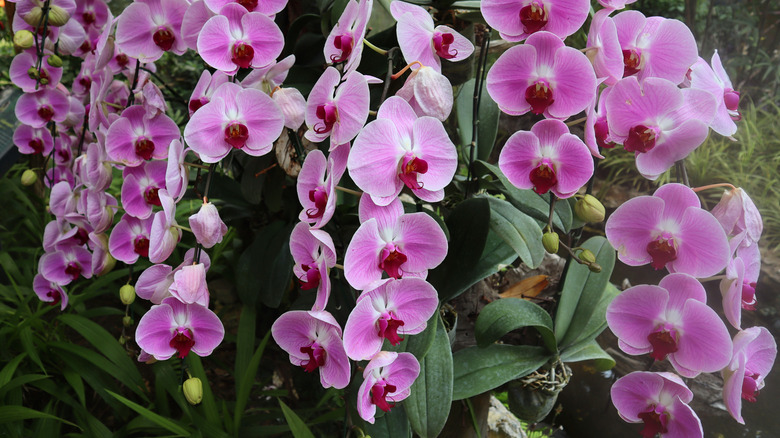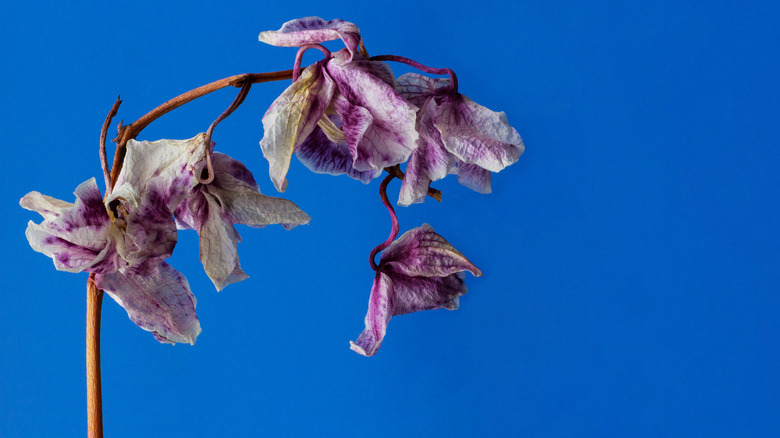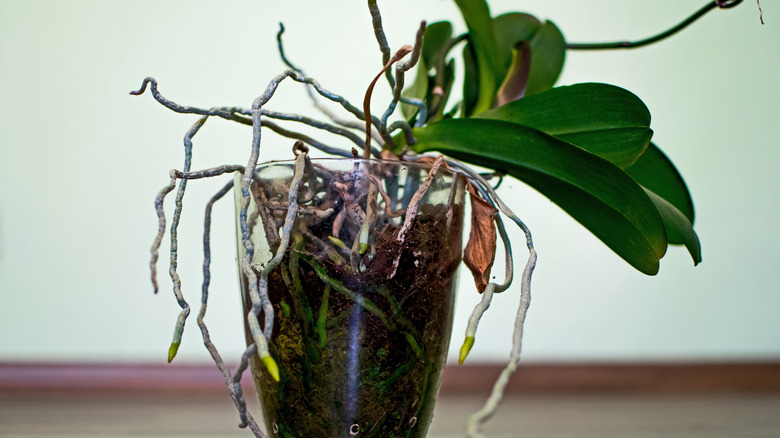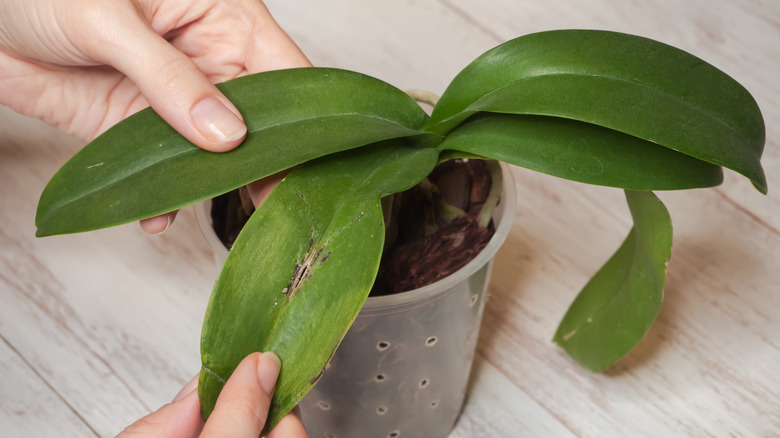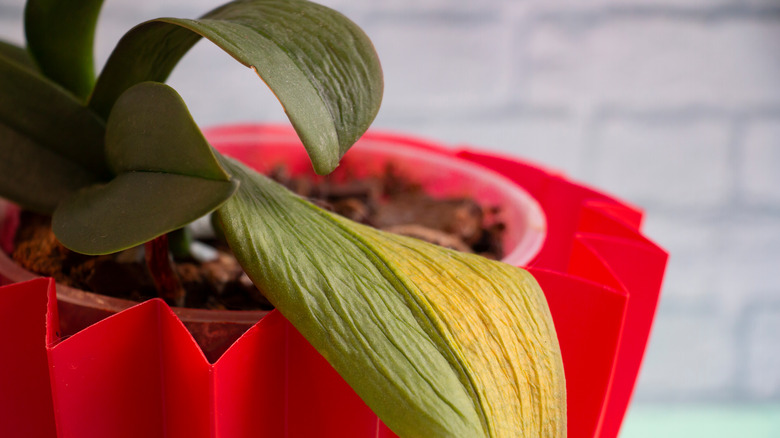Telltale Signs Your Orchids Are In Trouble
Anyone who's ever received an orchid as a housewarming gift or splurged on the exotic plant to give as a gift knows the undeniable sophistication and style it can add to a home, garden, or even a wedding. And not only are they beautiful — they have special meaning. According to Just Addice Orchids, these flowering plants symbolize love, strength, wealth, and beauty. So when you do get your hands on one of these elegant arrangements, the last thing you want to see is that lovely meaning slip away.
Phalaenopsis orchids, otherwise known as "moth orchids," are some of the most common of this luxurious plant family (via Longwood Gardens). If you have one in your home and you're scratching your head after a week or two at the mess of fallen leaves, wondering whether you're a terrible plant parent, don't fret just yet — orchids are known for being a finicky, fussy flower with a mind of their own. One day they could be dormant and fooling you into thinking they're on their way out, and with a little extra TLC, the next day they can be blooming like new. We are here to give you a bit of advice so you can tell how to determine whether or not your orchid is actually in the clear before you get frustrated and swap it for something a little more predictable. They may be unpredictable flowers, but they are worth the extra fuss you may have to give them.
Consider premature wilting a major warning sign
So everything was coming up orchids, and the birds were even chirping. But if your orchid has seen happier days (and the birds stopped chirping), you need to determine whether your orchid is salvageable or not, and that means you need to backtrack. Try to think back and remember when you purchased or received the plant. If the orchid was in full bloom at the time when you first got it, you should have at least 3 full weeks — if not longer — before you see any signs of wilting. But that's as long as you've been doing everything you needed to be doing and have been taking proper care of the plant all along (via Your Orchid Questions). If your orchid looks dreary and droopy in less than a month's time, then you likely need to tweak your watering routine to start reviving the dry plant before it's too late.
Now if the orchid is wilting earlier than that period of time, there may be cause for some serious intervention. You'll need to observe and keep tabs on the order in which your flowers are wilting. If the older ones lowest on the spike show signs of wilting first, then chances are, the plant is just showing its age. Your Orchid Questions also noted that if all of the wilting is occurring on one side, then the plant was likely damaged at some point, and it may be hard to recover.
Brown roots signal severe overwatering
On the flip side — and if you're a gardener, then you've certainly heard this one before — make sure to avoid overwatering your orchid at all costs. You'll know when to start worrying when you take a quick glance at your orchid's roots. They should be white and bright with a hint of green towards the tips and firm to the touch. If they're brown, soft, or missing altogether, then you might have a serious problem: root rot (via SFGate).
Root rot, or the death of the plant's roots, occurs when there's so much water in the roots that they turn into a bit of a mess. The orchid won't be capable of soaking up the nutrients it needs via the roots, leading to irreversible damage and likely another dead houseplant, as per SFGate. The silver lining? By keeping a steady eye on your plants' roots, you can catch the rot before it's too late and prune the damaged portions. As long as some of the roots are healthy and functioning, your orchid should be able to bounce back with a little bit of extra rehab and attention.
Look out for light damage
Greenery lovers typically flock to their light and bright windowsills to house their pride and joy plants, and it makes perfect sense — plants love the sun, and the sun sure loves plants right on back. Unfortunately, just like with beach-loving humans, the sun isn't always your number one friend.
Believe it or not, orchids are prone to light damage, which manifests itself in small sun spots all over the glowy, shiny leaves. Your Orchid Questions explained that you can typically diagnose this when the spots are a reddish hue, and it's easily fixable by moving the orchid into an area with a little less natural light.
The American Orchid Society echoed this warning, explaining that these plants can get a "sunburn," too. In more severe cases, the spots might turn dark brown or black due to direct bright light. So long as you aren't seeing any white spots or serious indents on the foliage, you should be able to reverse the sun damage with a little time in the shade.
Wrinkled foliage is a worrisome sign
Crumbly, dry leaves are not good to see on your plant. They go hand in hand with two of the biggest orchid mishaps: the plant is getting too much sun, or your orchid is not getting enough water. Either way, crumbly, dry leaves aren't attractive to see on your pretty plant, and the situation needs to be addressed. Now let's get to the bottom of this issue as soon as possible so your orchid will start smiling again.
According to Your Orchid Questions, a thin and almost flaky leaf is indicative of your plant getting too much heat (a problem that can come up time and time again during the summer season for orchid owners). If your leaves aren't looking thin, but rather they appear to be shriveled and leathery, that's a telltale sign that your orchid is not receiving the proper nutrients it needs from the roots. Neither situation is a good one, but it's really not too late to figure things out.
You're looking at two scenarios here: Either you've overwatered your orchid to the point of root rot (We've all been there and done that, so don't feel so bad.), or you've under-watered your plant and it's begging for a bit of help and water, according to the American Orchid Society. Start your first aid by double-checking your plant's roots to determine if watering is the source of the issue, and then make some moves to revive your precious houseplant!
Regularly check your orchid's crown
If you can't seem to track down the cause of the growing number of fallen orchid petals you have, there's one more place to check aside from the tips of the leaves and bottom of the roots. One of the most common ailments for Phalaenopsis orchids starts in the crown, or where the leaves connect with the base of the orchid plant (via Just Addice Orchids). Since these orchids are typically indoor houseplants, they are often potted and poised for the dreaded crown rot. Gardening Know How explained that crown rot happens when water accumulates below the leaves, which is a typical mistake that people make when dealing with a potted plant. If the pot doesn't drain effectively throughout the day, it can eat away at the crown and slowly kill your new favorite plant.
If you do come across a case of crown rot, there are a few easy fixes, as noted by Gardening Know How. Try pouring a little bit of hydrogen peroxide on the spot now and again over a few days, letting it bubble and clean the area. Then, sprinkle some cinnamon on top to help fight any future fungus — and whatever you do, keep on watching your watering!
If you keep these tips close at hand, with a little love and lots of care, you can enjoy growing beautiful, happy, and healthy orchid plants in your home and get lots of compliments on them, too.
